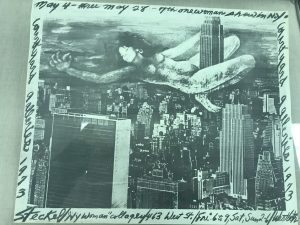The National Museum of Women in the Arts (NMWA), the first in the world solely dedicated to elevating women’s art and creativity, is set to reopen Oct. 21 after two years and $70 million in renovations. The museum, just three blocks from the White House, will resume its mission of disrupting the male-dominated art industry, heralding its reopening with six new exhibitions and state-of-the-art programming spaces.
“Here at the National Museum of Women in the Arts, we are called to a dual purpose. To exhibit works by women artists and to advocate in the larger field. I like to say we are both a museum and a megaphone,” NMWA Director Susan Fisher Sterling said in her opening remarks at an Oct. 17 press preview of the museum.
The museum was founded in 1987 by art enthusiast Wilhelmina Holladay in response to a lack of representation of women artists in museums and history books. Since its inception, its goal has been elevating diverse perspectives in women’s art, according to Sterling.
“[In 1987], we were at that point also thinking about what it meant to be left out of the picture, to be oppressed, to be not taken seriously, to be marginalized,” she said in an interview with the Voice.
In a 2018 study, researchers found 87 percent of collections at 18 major U.S. art museums were by men.
“Despite lip service that everything is changing, gender inequity in the arts continues, making our advocacy more relevant than ever,” Winton Holladay, chair of the NMWA board, said at the press preview.
To accompany its reopening, NMWA will debut its inaugural exhibition “The Sky’s the Limit,” which illustrates how women can create bold and powerful art, according to Sterling. The collection features a series of hanging installations, including a glass sculpture by Brazilian artist Beatriz Milhazes weighing a shocking 450 pounds.
Other new exhibitions include “In Focus: Artists at Work,” which includes a series of short documentary-style films looking at different artists’ methods and perspectives, and Hung Liu: Making History, a series of paintings and prints by Hung Liu that pays homage to those often forgotten by history—primarily women and children from her native China.
The renovations to the historic building focused on expanding the museum’s offerings to the public and were spearheaded by Sandra Parsons Vicchio, the principal architect on the project. Upon reopening, it will boast changes such as a renovated Performance Hall and a new Learning Commons (which includes the new Library and Research Center and the Susan Swartz Studio). The studio will begin offering hands-on workshops hosted by both local and visiting artists in early December.
Sterling expressed her excitement at finally welcoming visitors.
“What I always hope is that they’ll feel welcome, and that they’ll feel like they’ve been invited into a place that respects them, and that they’ll be able to see themselves or understand their experience through something they see in the museum,” she said in an interview with the Voice.
The museum’s presentation of art pairs historical work with contemporary art in each exhibit. In breaking the art timeline, Sterling said the museum aims to bring new and more diverse voices to the forefront of their galleries, since art history typically constrains female and diverse creators to the modern day.
“Chronology has always short-shrifted women and persons of color. So by breaking chronology, you break that tradition of 2,000 years of history that is told by men,” Sterling said. “If you come to NMWA, you’ll have a different experience that’s not old art history.”
Instead of chronologically, the museum groups art by themes, including the new themes titled “Shrinking Violet,” “Seeing Red,” and “Heavyweight,” which features large sculptures to combat the idea that women create small works. To Sterling, each grouping—based on the idea of “busting myths about women”—takes traditionally negative connotations about women and instead reclaims the monikers through artistic expression.
Senior curator Ginny Treanor highlighted the new technologies implemented during the renovation. These include kiosks with touch screens for visitors to explore the galleries and learn more about the art.
“I am really excited about the technology that we’ve incorporated into the galleries and it’s all very thoughtful. We didn’t want to have tech just to have tech,” Treanor said.
The museum will welcome visitors with an opening day of festivities including flash tattoos by D.C. artist Bibi Abelle, button-making, free sketchbooks, and a performance from Afro-Brazilian all-female percussion band Batalá Washington. The first weekend of its opening, the museum is offering free admission; an adult ticket usually costs $16.
Sterling reiterated her excitement to welcome visitors to the revitalized building and galleries, just in time to celebrate the founder’s birthday.
“Mrs. Holladay would have been 101 this month, and I think she’d be really happy.”




